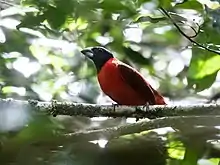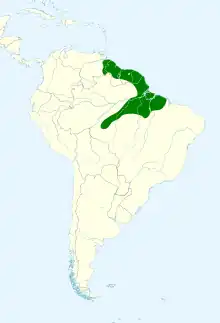Red-and-black grosbeak
The red-and-black grosbeak (Periporphyrus erythromelas) is a species of bird in the family Cardinalidae, the cardinals or cardinal grosbeaks. It is found in Brazil, French Guiana, Guyana, Suriname, and Venezuela.
| Red-and-black grosbeak | |
|---|---|
 | |
| Scientific classification | |
| Domain: | Eukaryota |
| Kingdom: | Animalia |
| Phylum: | Chordata |
| Clade: | Dinosauria |
| Class: | Aves |
| Order: | Passeriformes |
| Family: | Cardinalidae |
| Genus: | Periporphyrus |
| Species: | P. erythromelas |
| Binomial name | |
| Periporphyrus erythromelas (Gmelin, JF, 1789) | |
 | |
| Approximate range | |
Taxonomy
The red-and-black grosbeak was formally described in 1789 by the German naturalist Johann Friedrich Gmelin in his revised and expanded edition of Carl Linnaeus's Systema Naturae. He placed it in the genus Loxia and coined the binomial name Loxia erythromelas.[2] The specific epithet is from Ancient Greek and means "blackish-red" or "red and black"; eruthros means "red" and melas means "black".[3] Gmelin based his description on the "black-headed grosbeak" that had been described and illustrated in 1783 by the English ornithologist John Latham in his book A General Synopsis of Birds. Latham had examined specimens from Cayenne at the Leverian Museum in London.[4] The red-and-black grosbeak is now placed with the crimson-collared grosbeak in the genus Periporphyrus that was introduced by German naturalist Ludwig Reichenbach in 1850. It is monotypic: no subspecies are recognised.[5]
Description
The red-and-black-grosbeak is 20.5 cm (8.1 in) long; one male weighed 48 g (1.7 oz). Both sexes have a heavy black bill and their entire head including the throat is black. The male's nape, breast, and belly are bright red and its back is a deep red. The female's upper parts are dark greenish yellow and the underparts yellowish green. The immature male has a similar color scheme to the adult but it is duller.[6]
Both sexes of red-and-black grosbeak sing "an exceptionally sweet series of halting phrases" . Its call is a "sharp 'spink'" .[6]
Distribution and habitat
The red-and-black grosbeak is primarily found from far eastern Venezuela east through the Guianas and into northern Brazil. It has also been observered in Brazil south of the Amazon River. It inhabits mature humid terra firme and várzea forest from sea level to 1,000 m (3,300 ft).[6]
Behavior
Feeding
The red-and-black grosbeak forages in the lower levels of the forest for arthropods and seeds. It does not join mixed-species foraging flocks but feeds in pairs or family groups.[6]
Status
The IUCN has assessed the red-and-black grosbeak as being of Least Concern. Between 2012 and 2018 it had been considered Near Threatened.[1]
References
- BirdLife International (2020). "Red-and-black Grosbeak Periporphyrus erythromelas". IUCN Red List of Threatened Species. 2020. Retrieved 10 December 2020.
- Gmelin, Johann Friedrich (1789). Systema naturae per regna tria naturae : secundum classes, ordines, genera, species, cum characteribus, differentiis, synonymis, locis (in Latin). Vol. 1, Part 2 (13th ed.). Lipsiae [Leipzig]: Georg. Emanuel. Beer.
- Jobling, James A. (2010). The Helm Dictionary of Scientific Bird Names. London: Christopher Helm. p. 150. ISBN 978-1-4081-2501-4.
- Latham, John (1783). A General Synopsis of Birds. Vol. 2, Part 1. London: Printed for Leigh and Sotheby. p. 150, Plate 43.
- Gill, Frank; Donsker, David; Rasmussen, Pamela, eds. (July 2023). "Cardinals, grosbeaks and 'tanager' allies". IOC World Bird List Version 13.2. International Ornithologists' Union. Retrieved 14 July 2023.
- Brewer, D. (2020). Red-and-black Grosbeak (Periporphyrus erythromelas), version 1.0. In Birds of the World (J. del Hoyo, A. Elliott, J. Sargatal, D. A. Christie, and E. de Juana, Editors). Cornell Lab of Ornithology, Ithaca, NY, USA. https://doi.org/10.2173/bow.rabgro1.01 retrieved may 14, 2021
